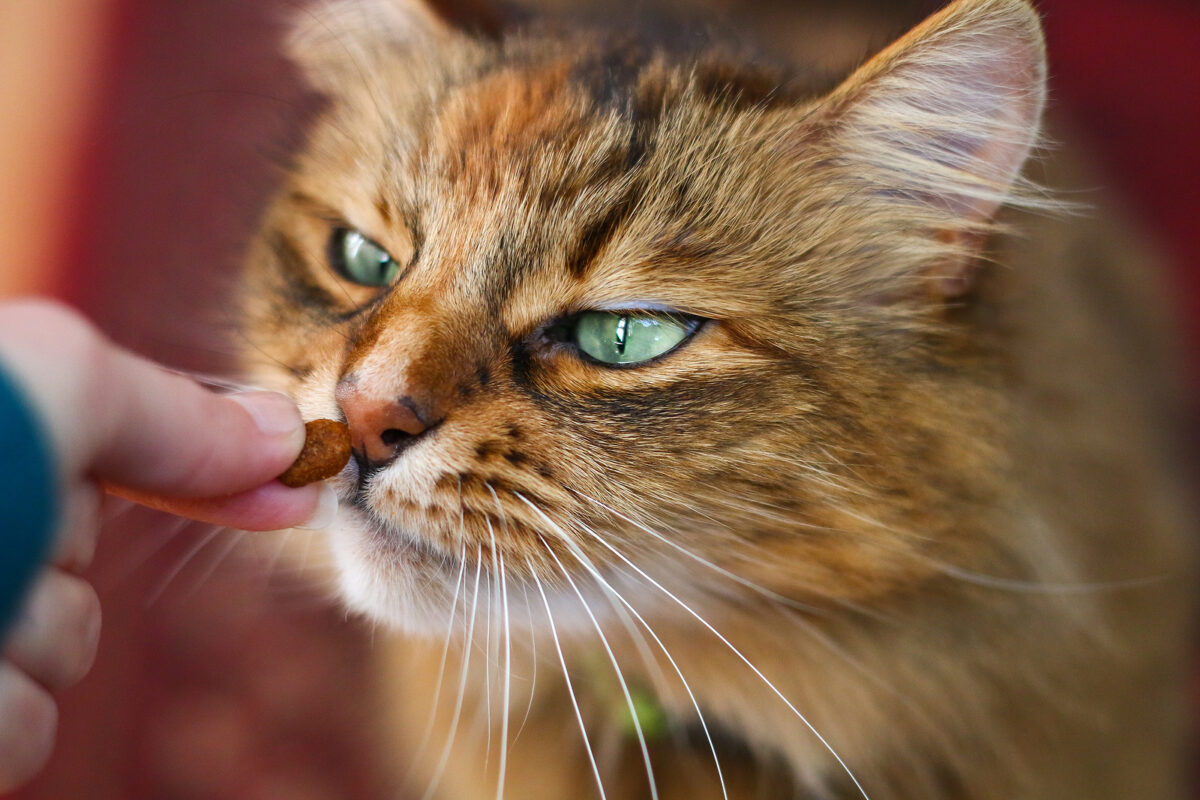Nature is pretty smart. To survive, creatures are designed to crave the food and behavior that they need to be healthy. For example, humans are a social species, and we are omnivores. We evolved to eat a variety of foods served three times a day with the company of others.
Humans sometimes have a hard time understanding that any way other than the human way of eating could possibly make sense. We simply can’t imagine that our cats are not best cared for when they are served three meals a day, just like us. But cats behave differently and crave foods differently than people. As a result, we often interpret normal and innate cat feeding behavior incorrectly. What we call finicky is absolutely normal for a cat.
You may have heard that cats are “obligate carnivores.” This means that cats must eat meat. But why? Couldn’t your cat be a vegetarian just like you? No. Cats evolved as hunters that consume only their prey.
Cats’ prey, such as mice and birds, are high in protein, moderate in fat, and very, very low in carbohydrates. Nutritionally, their daily energy intake needs to be about 52 percent protein, 46 percent fat, and only 2 percent carbohydrates, which are sugars and starches. Cats’ bodies must have animal protein to convert into energy. If the food your cat eats is higher in carbohydrates and lower in protein, your cat may eat more volume of that food to get enough protein. In short, your cat may be overeating in total calories to be able to get enough protein.
Cats need to get more than a dozen vitamins, minerals, fatty acids, and amino acids directly from their food. They need to get the finished product of taurine, arginine, histidine, isoleucine, leucine, lysine, methionine, phenylalanine, threonine, tryptophan, and valine from the meat they eat. Many other mammals don’t need to consume these finished products in their diet. Other mammals’ bodies can create these nutrients out of their components to meet their nutritional needs. Cats’ bodies cannot do this.
To make sure cats get what they need, Mother Nature drives cats’ taste preferences accordingly. In general, cats prefer foods high in moisture, protein, certain amino acids, and fat.
Kittens learn food preferences and identification of what qualifies as food in the first couple of months of life. In a feral setting, for instance, kittens learn to prey on animals their mother brings them.
Cats can also have specific texture preferences. We don’t know why that is, but individual cats may have a strong preference for wet food versus dry, for certain types of wet food (paté, shreds, stews), or for certain shapes of dry food.
We focus on what cats eat, but we often don’t consider how cats eat. In nature, a cat will hunt, catch, kill and eat 8 to 12 mice every 24 hours. A meal for a cat starts with the hunt and ends with a Ping Pong-ball-size meal of about 30 calories. Cats should eat about eight meals of this size a day. This is equivalent to 10 to 15 pieces of your average kibble, or three or four bites.
Humans eat three large meals a day and if we don’t clean our plates it is likely because we don’t care for our food. We assume that the same is true for our cats. When we see our cats amble up to the bowl, take three bites of food and walk away, we label them finicky and the food a failure, when that is completely appropriate for a cat meal and exactly what a cat should be doing when presented with a large bowl of food. To make matters worse, we are so convinced that our cat is finicky and the food is being rejected that we go out and find a food that is irresistible to our cat. We find a food that is so scrumptious that our cats will override their body signals and eat a huge portion. We are causing our cats to become obese.
For a cat, a meal is more than just a proper portion of protein, fat, and carbohydrates. Hunting and interacting with small portions of appropriate food many times a day is hardwired into their brain. Give your cat what they really need and provide a way for them to hunt, catch, and play with whatever you feed them 6 to 12 times a day. The more small meals a cat interacts with in a day, the more physically and behaviorally healthy they become.
Is your cat finicky? Probably not. More than likely, your cat is just being a cat and no one ever told you what that was. I hope this helps!
This article was reviewed/edited by board-certified veterinary behaviorist Dr. Kenneth Martin and/or veterinary technician specialist in behavior Debbie Martin, LVT.








